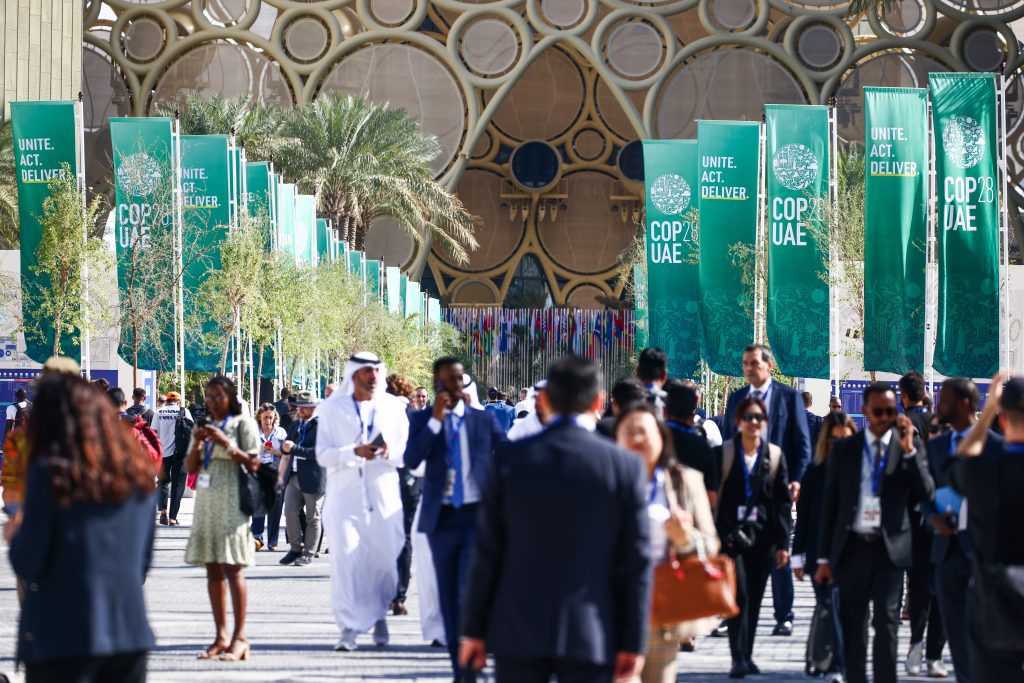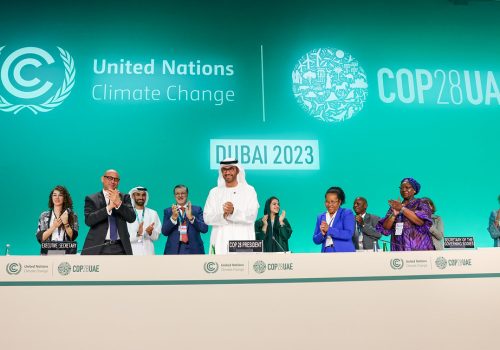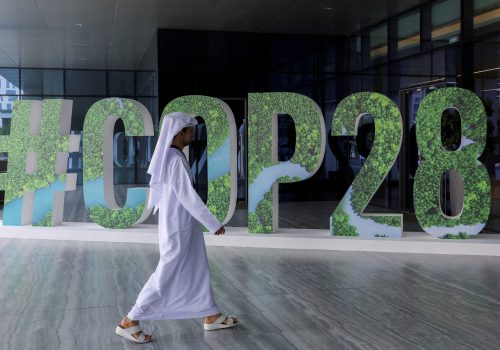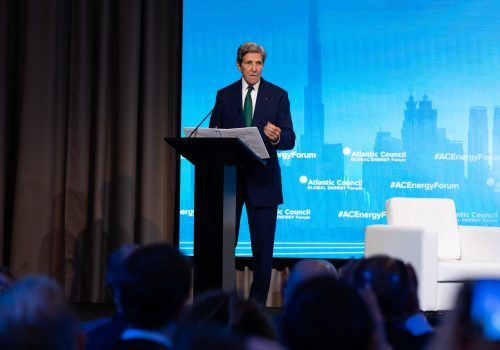Standing at the epicenter of the United Nations Climate Conference in Dubai, also known as COP28, it was clear that this year’s event was qualitatively different from previous ones. What started in Berlin in 1995—convened by Angela Merkel, then the German environmental minister, as a private meeting of experts seeking to draw the attention of leaders and the media to the increase in global average temperatures—has become a prominent and massive gathering. Over the course of two weeks, more than 150 heads of state and government walked the halls of Expo City Dubai, compared to 112 who attended COP27 last year in Sharm El Sheikh, Egypt. There were also reportedly more than 90,000 participants at COP28, compared to less than 50,000 at COP27.
With the increase in size, COP’s center of gravity shifted away from the formal management structure of the convention. Instead, the focus was on disparate and scattered initiatives in which nonstate actors—including from the private sector—play a prominent role. There are several ways to interpret this conference: a holy pilgrimage for those who are devoutly green, a new Davos attended by executives of the same corporate giants who frequent the World Economic Forum gathering in Switzerland, a photocall of politicians from around the world, a theater with armies of lobbyists, a mix of consultants and media. “Inclusion” was an oft-repeated theme this year. And although it may seem provocative, the meeting’s most notable decision may have been to include the oil and gas sector, which had been previously sidelined—a decision that spotlighted a larger confrontation at COP28 between ideology and pragmatism.
A new energy era
Strategic ambitions have historically revolved around energy, a substantive battle in international relations. The nineteenth century can be understood as the era of coal, driving the development of the manufacturing industry and rail transportation. World War I marked the beginning of the era of oil. (Controversy surrounded Winston Churchill’s decision, as the civilian head of the British Royal Navy, to switch the fleet to this fuel in 1913.) The current century will witness an “energy transition” intended to move the world toward a sustainable future. However, as “green” ideologies have come to dominate public discourse, the concept of a “transition” is too often lost: specifically, the idea that it will extend over time and require overlap. Countries must invest in renewables while continuing to rely on fossil fuels, which currently represent around 80 percent of the global energy mix (a figure that has stubbornly persisted since the world began to monitor the consequences of anthropogenic greenhouse gases).
The expectation of continued growth in demand through 2050 further complicates the global trilemma—ensuring a reliable energy supply at an affordable price while also accounting for the environmental dimension. Considering today’s technological framework, any solution to the equation likely involves replacing coal with gas—along with the return of nuclear—which is the most effective way to reduce emissions in situations where alternative sources are not conducive. Provided, of course, that “inclusive” and “equitable” are not just formulaic terms, and that “leaving no one behind” is more than a stylistic clause. In other words, Europe and other wealthy countries can afford to do away with coal or nuclear, or even to bet completely on renewables. But in the rest of the world, if a choice needs to be made between prosperity and the environment, the former will likely win out.
Today there is growing awareness of the urgency of the climate crisis. Far from being a technical dialogue among scholars, the climate conversation has permeated society; ordinary citizens around the world feel involved. Education has become not only positive but essential. Given that development, it is necessary to review the messages being sent; to reconsider the apparent dichotomy between renewable energies (presented as unquestionably good) and coal, oil, natural gas, and nuclear. These have been collectively condemned without considering their different contributions to what should be our only goal: combating the accumulation of greenhouse gases in the atmosphere.
The challenge ahead
The historic language enshrined in the final—although nonbinding—deal of the summit urging countries toward “transitioning away from fossil fuels” reflects a collective commitment to the energy transition that is taking shape. At the same time, there was progress in efforts to align hydrocarbons, and particularly gas, with sustainability goals, in recognition of their continued importance. Two initiatives stand out: a push to abate methane emissions, in particular from venting, flaring, and leaks; and a sharpening focus on the capture, storage, and eventual use of carbon dioxide throughout the gas value chain, starting with extraction.
Equally transformative is the return of interest in nuclear power, following a long period of rejection that occurred despite it being one of the most efficient and reliable energy sources (even with the challenge of waste from current reactors). The deal reached two weeks ago has opened a horizon that, a year ago, would have been unimaginable: Twenty-two countries have committed to tripling their nuclear capacity by 2050. US climate envoy John Kerry has even emphasized that the world cannot achieve net zero by 2050 without some nuclear energy.
An initiative announced by European Commission President Ursula von der Leyen is also worth mentioning: More than a hundred countries have joined the Global Commitment on Renewable Energy and Energy Efficiency. It sets two goals: tripling installed renewable capacity and doubling the rate of improvements in energy efficiency, both by 2030. This effort must be accompanied by widespread electrification, a transformation that will require the rare earths and other critical minerals that have become indispensable in new energy technologies. Their concentration in certain areas presents a series of challenges, as does the almost monopolistic control of China over their extraction and processing. Currently, there is an effort to replace these minerals with more common, more abundant elements—although the necessary technology is still being developed.
The challenge coming out of COP28 is to consolidate a pragmatic vision, a global objective that values all three components of the energy trilemma. The vision must take into account the heightened energy demand that will accompany the global population growth expected in the next thirty years—an anticipated increase of two billion people—and must understand that for now fossil fuels inevitably will continue to play a significant role in meeting that demand.
The most pressing challenges of our century are clear: The world needs to multiply installed renewable capacity and advance electrification, along with its corollary of a constant supply of necessary critical minerals and rare earths. What’s also needed are efforts to develop a natural gas that is increasingly less polluting. And finally, nuclear skeptics need to make peace with nuclear energy.
A version of this article originally appeared in El Mundo. It has been translated from Spanish by the staff of Palacio y Asociados and is reprinted here with the author’s and publisher’s permission.
Ana Palacio is a former minister of foreign affairs of Spain and former senior vice president and general counsel of the World Bank Group. She is also a visiting professor at the Edmund E. Walsh School of Foreign Service at Georgetown University and a member of the Atlantic Council’s Board of Directors.
Further reading
Fri, Dec 15, 2023
COP28’s legacy will be measured by emissions reduction, not ‘historic’ text
EnergySource By Landon Derentz
The COP28 final declaration is transformational in its reflections on fossil energy's role in climate change. The conference's real legacy, however, will be the efforts undertaken to foster the inclusive platform necessary to promote private and public actions and reduce global emissions.
Thu, Nov 30, 2023
Expert analysis: The successes and shortcomings in the fight against climate change at COP28
New Atlanticist By
Our experts dispatched to Dubai, where they analyzed how global leaders responded to the greatest challenges posed by climate change.
Wed, Dec 6, 2023
John Kerry unveils a ‘critical’ new US strategy to expand fusion energy
New Atlanticist By Katherine Golden
"We need to pull ourselves together with every strength we have,” Kerry said on the first day of the Global Energy Forum.
Image: The 28th Conference of the Parties to the United Nations Framework Convention on Climate Change, which takes place on 30 November until 12 December 2023 in Expo City Dubai. Dubai, United Arab Emirates on December 1st, 2023. (Photo by Beata Zawrzel/NurPhoto)



